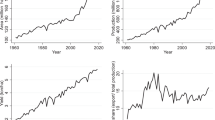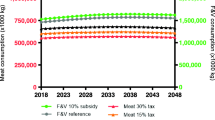Abstract
A study was conducted to examine the interrelationships among socioeconomic factors, household consumption patterns, calorie intake and greenhouse gas emissions factors in rural eastern India based on household survey data. Findings indicated that higher monthly per capita incomes (12.1–80.1$) were associated with greater average calorie intakes (2021–2525 kcal d−1). As estimated by the FEEDME model, in total 17.2% of the population was calorie malnourished with a regional disparity of 29.4–18.2% malnourishment. Greenhouse gas (GHG) emissions were calculated only on the basis of crop and livestock production and consumption. Rice accounted for the highest share of total GHG emissions, on average 82.6% on a production basis, which varied from 58.1% to 94.9% in regional basis. Rice contributed the greatest share (~ 65% and 66.2%) in terms of both calories and GHG emissions (CO2 eq y−1), respectively, on a consumption basis. We conclude that extensive rice farming and increasing animal product consumption are dominant factors in the higher carbon footprint in this region and are likely to further increase with increase in per capita income. This study provides useful information to help for better crop planning and for fine-tuning food access policy, to reduce carbon footprint and calorie malnutrition.





Similar content being viewed by others
References
Abdulai, A., & Aubert, D. (2004). Nonparametric and parametric analysis of calorie consumption in Tanzania. Food Policy, 29, 113–129.
Alkerwi, A., Vernier, C., Sauvageot, N., Crichton, G. E., & Elias, M. F. (2015). Demographic and socioeconomic disparity in nutrition: Application of a novel correlated component regression approach. British Medical Journal Open, 5, 1–11. https://doi.org/10.1136/bmjopen-2014-006814.
Babatunde, R. O., Adejobi, A. O., & Fakayode, S. B. (2010). Income and calorie intake among farming households in rural Nigeria: Results of parametric and nonparametric analysis. Journal of Agricultural Science, 2, 135–146.
Barrett, C. B. (2010). Measuring food insecurity. Science, 327(5967), 825–828.
Bellarby, J., Tirado, R., Leip, A., Weiss, F., Lesschen, J. P., & Smith, P. (2013). Livestock greenhouse gas emissions and mitigation potential in Europe. Global Change Biology, 19, 3–18.
Census of India (2011). Household Schedule-Side A" (PDF). Office of the Registrar General & Census Commissioner, Ministry of Home Affairs Government of India, http://www.censusindia.gov.in/2011-common/census_2011.html
Cetin, M., Adiguzel, F., Kaya, O., & Sahap, A. (2018). Mapping of bioclimatic comfort for potential planning using GIS in Aydin. Environment Development and Sustainability, 20(1), 361–375. https://doi.org/10.1007/s10668-016-9885-5.
Dangour, A., Pradhan, A., Islam, Md. S. (2017). Sustainable Farming Systems for Food and Nutrition Security. FAO: Global Forum on Food Security and Nutrition • FSN Forum. http://www.fao.org/fsnforum/activities/discussions/sustainable-farming-systems
Das, S. (2016). Malnutrition in Odisha. International Journal Management Social Science Research, 5, 20–28.
Dawson, T. P., Perryman, A. H., & Osborne, T. M. (2016). Modelling impacts of climate change on global food security. Climatic Change, 134, 429–440.
Department of Agriculture. (2016). Odisha agriculture statistics 2015–16, directorate of agriculture & food production. Bhubaneswar, Odisha: Govt. of Odisha.
Department of Fisheries and Animal Resources Development (2016). Annual activity report 2015–16. Department of Fisheries and Animal Resources Development, Govt. of Odisha, Bhubaneswar, Odisha.
Directorate of Economics & Statistics (DES) (2011–12). Govt. of Odisha, Level and pattern of consumer expenditure of Odisha. 68th Round NSS 2011–12. Assessed by http://www.desorissa.nic.in/pdf/nss-68-consumer-expenditure.pdf
FAO. (2004). FAO methodology for estimating undernourishment. Rome: Food and Agriculture Organisation.
FAO ( 2008). The state of food insecurity in the world, Rome.
FAO/WHO/UNU (2004). Human Energy Requirements. Report of a Joint FAO/WHO/UNU Expert Consultation. Rome, FAO, FAO Food and Nutrition Tech. Report Ser. 1
Gopalan, C., Rama Sastri, B. V., & Balasubramanian, S. C. (1989). Nutritive value of Indian foods. Indian Council of Medical Research, Hyderabad, India: National Institute of Nutrition.
Government of Odisha. (2005). Human development report 2004. New Delhi: Planning Commission.
Hillier, J., Walter, C., Malin, D., Garcia-Suarez, T., Mila-i-Canals, L., & Smith, P. (2011). A farm-focused calculator for emissions from crop and livestock production. Environment Modelling Software, 26(9), 1070–1078.
Human Development Report (2004). Government of Odisha (p. 325).
Ittyerah, A. C. (2013). Food security in India: issues and suggestions for effectiveness. Theme paper for the 57th Members’ Annual Conference, Indian Institute of Public Administration, New Delhi, India. http://www.iipa.org.in/upload/Food%20Security%20Theme%20Paper-2013.pdf (assessed on November 2017)
James, W. P. T., & Schofield, E. C. (1990). Human energy requirements. Oxford: Oxford University Press.
Kim, B., & Neff, R. (2009). Measurement and communication of greenhouse gas emissions from U.S. food consumption via carbon calculators. Ecological Economics, 69(1), 186–196.
Kumbhar, R. K. (2013). Structural legacy, inefficacy and weakening social securities: A study of NREGS in a panchayat in Odisha. In K. P. Kannan & Jan Breman (Eds.), the long road to social security: Assessing the implementation of national social security initiatives for the working poor in India. India: Oxford University Press.
Kumbhar, R. K. (2016). State of calories intake in Odisha and role of public policies. International Journal of Human Social Science Research, 2(6), 29–34.
Liu, S., Qin, Y., Zou, J., & Liu, Q. (2010). Effects of water regime during rice-growing season on annual direct N2O emission in a paddy rice–winter wheat rotation system in southeast China. Science of the Total Environment, 408(4), 906–913.
Ma, J., & Maystadt, J.-F. (2017). The impact of weather variations on maize yields and household income: Income diversification as adaptation in rural China. Global Environmental Change, 42, 93–106.
Mangal, A., Kumar, V., Panesar, S., Talwar, R., Raut, D., & Singh, S. (2015). Updated BG Prasad socioeconomic classification, 2014: A commentary. Indian Journal of Public Health, 59(1), 42–44.
Nayak, D., Saetnan, E., Cheng, K., Wang, W., Koslowski, F., Cheng, Y., et al. (2015). Management opportunities to mitigate greenhouse gas emissions from Chinese agriculture. Agriculture Ecosystems Environment, 209, 108–124.
Odisha Economic Survey (2014-15). Planning and Co-ordination Department, Government of Odisha (p. 540).
Odisha Economic survey (2015). Planning and convergence department, Govt. of Odisha, Bhubaneswar, 2014–15. http://www.odisha.gov.in/pc/Download/Economic_Survey_ 2014–15.pdf. (Assessed on November 2017)
Oldiges, C. (2012). Cereals consumption and per capita income in India. Economic and Political Weekly, 47(6), 63–71.
Pathak, H., Jain, N., Bhatia, A., Patel, J., & Aggarwal, P. K. (2010). Carbon footprints of Indian food items. Agriculture Ecosystems Environment, 139(1–2), 66–73.
Rath, R. (2006). Education of tribal children in Kandhamal district. Orissa Review, 62(10), 50–59.
RIVM (1997). National Environmental Outlook 4, 1997-2020. Samson H. D., Tjeenk Willink bv., Alphen aan den Rijn, The Netherlands.
Schmidhuber, J., & Tubiello, F. N. (2007). Global food security under climate change. PNAS, 104(50), 19703–19708. https://doi.org/10.1073/pnas.0701976104.
Singh, N., & Singh, N. (2016). Economic transformation of a developing economy: The experience of Punjab. India: Springer.
Smith, P., Bustamante, M., Ahammad, H., Clark, H., Dong, H., Elsiddig, E. A., Haberl, H., Harper, R., House, J., Jafari, M., Masera, O., Mbow, C., et al. (2014). Agriculture, forestry and other land use (AFOLU). In “Climate Change 2014: Mitigation of climate change. contribution of working group iii to the fifth assessment report of the intergovernmental panel on climate change” O. Edenhofer, et al. (Ed.) (pp. 811–922). Cambridge University Press, Cambridge, United Kingdom and New York, NY, USA.
Strauss, J., & Thomas, D. (1995). Human resources: Empirical modelling of household and family decisions. In J. Behrman & T. N. Srinivasan (Eds.), Handbook of development economics (3rd ed., pp. 1883–2023). Amsterdam: North-Holland.
Subramanian, S., & Deaton, A. (1996). The demand for food and calories. Journal of Political Economy, 104(1), 133–162.
Tuomisto, H. L., Scheelbeek, P. F., Chalabi, Z., Green, R., Smith, R. D., Haines, A., & Dangour, A. D. (2017). Effects of environmental change on agriculture, nutrition and health: A framework with a focus on fruits and vegetables. Wellcome Open Research, 2, 21.
Vermeulen, S. J., Campbell, B. M., & Ingram, J. S. I. (2012). Climate change and food systems. Annual Reviews in Environmental Resource, 37, 195–222.
Vetter, S. H., Sapkota, T. B., Hillier, J., Stirling, C. M., Macdiarmid, J. I., Aleksandrowicz, L., et al. (2017). Greenhouse gas emissions from agricultural food production to supply Indian diets: Implications for climate change mitigation. Agriculture Ecosystems Environment, 237, 234–241.
WHO (1995). Physical Status: the use and interpretation of anthropometry. WHO Technical Report Series 854. Geneva.
WHO (2004). Human Energy Requirements. Report of a Joint FAO/WHO/UNU Expert Consultation. Rome, FAO, FAO Food and Nutrition Tech. Rpt. Ser. 1.
WHO (2006). WHO Child Growth Standards: BMI for age tables. WHO. Geneva,. Available at http://www.who.int/childgrowth/standards/bmi_for_age/en/index.html
WHO (2007). WHO Growth reference 5–19 years: BMI for age tables. WHO, Geneva. Available at http://www.who.int/growthref/who2007_bmi_for_age/en/index.html
WHO/FAO/UNU (1985). Energy and Protein Requirements. Report of a joint FAO/WHO/UNU ad hoc Expert Consultation. Geneva, WHO, WHO Tech. Rpt. Ser 724.
Yan, X., Yagi, K., Akiyama, H., & Akimoto, H. (2005). Statistical analysis of the major variables controlling methane emission from rice fields. Global Change Biology, 11(7), 1131–1141.
Funding
Financial assistances for the conduct of study was provided by Ministry of Earth Sciences, and Indian Council of Agricultural Research, Government of India, New Delhi.
Author information
Authors and Affiliations
Corresponding author
Additional information
Publisher's Note
Springer Nature remains neutral with regard to jurisdictional claims in published maps and institutional affiliations.
Rights and permissions
About this article
Cite this article
Tripathi, R., Dhal, B., Shahid, M. et al. Agricultural GHG emission and calorie intake nexus among different socioeconomic households of rural eastern India. Environ Dev Sustain 23, 11563–11582 (2021). https://doi.org/10.1007/s10668-020-01126-w
Received:
Accepted:
Published:
Issue Date:
DOI: https://doi.org/10.1007/s10668-020-01126-w




